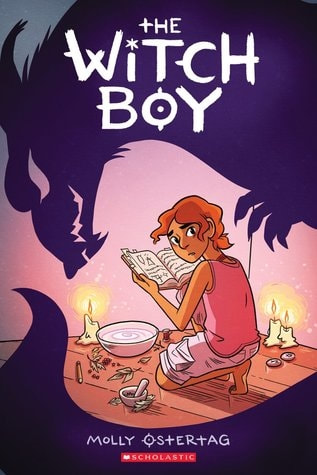The Witch Boy. By Molly Knox Ostertag. Scholastic/Graphix, 2017. ISBN 978-1338089516. $12.99, 224 pages.I met Molly Knox Ostertag at the Chevalier’s event on March 15, and that inspired me to read, at last, The Witch Boy, a talked-about graphic novel from last fall and now a finalist for the Excellence in Graphic Literature Awards. So, in the spirit of catching up: Billed as a middle grade fantasy, The Witch Boy envisions a clan of witches and shapeshifters on the edges of human society who subscribe to a strictly gendered division of roles: witches are women, and shapeshifters men. However, protagonist Aster is a boy whose magic leans toward witchery, not shifting. This is taboo. Aster’s family anxiously clings to its binarism; his witching strikes them as uncanny and ill-starred. This tale of forbidden skills and aspirations is also, implicitly, a coming-out story; the plot inverts the familiar premise of a girl braving to enter what is deemed a man’s field while also queering notions of gender identity. Indeed the novel exposes the unease that a queer or gender-nonconforming child can bring to an insular community. Aster, shamed and fretted over by his kin, finds support in a non-magical girl named Charlie (Charlotte), a young athlete of color whose own resistance to gender norms is quickly sketched. Charlie, blunt and unaffected, frees Aster up a bit, and helps him use his forbidden gifts to resolve a mystery that is threatening the boys of his clan—a mystery that traces back to his family’s very history of shaming those who do not fit their gender norms. The novel hurtles to an end with an outpouring of backstory from a wise grandmother who holds the key, plot-wise, and the conclusion brings not perfect harmony ("Mom and Dad don't really get it...") but acceptance and the promise of further adventures (sequels!). The Witch Boy is a promising solo debut from Ostertag, already a busy cartoonist and co-creator of several comics. She wrote, drew, lettered, co-designed, and (with help) colored the book, and the story feels personal. The artwork, expressive and clear, recalls Hope Larson for me, but Ostertag is looser and uses backgrounds more sparsely. Her storytelling pulls me through effortlessly, though at times atmosphere and setting seem too thinly (or hurriedly) drawn for full effect. The ending is baldly telegraphed, and the last threescore pages rush to get there, with hasty exposition. But I enjoy the world, including its multiracial and queer-positive families, and the fact that the grownups in it, even at their most fearful or unbending, are not caricatures but strong folk anxious to do right. There is potential for a complex series here, and I look forward to more from Ostertag. Soon, I gather!
0 Comments
Your comment will be posted after it is approved.
Leave a Reply. |
Archives
June 2024
|


 RSS Feed
RSS Feed
